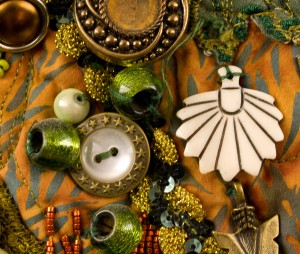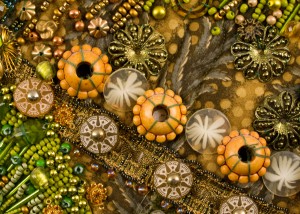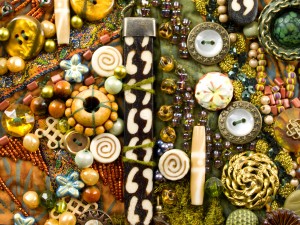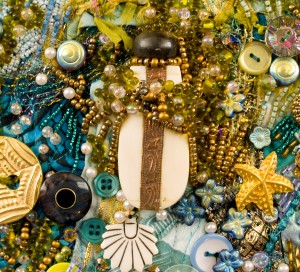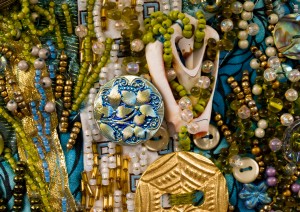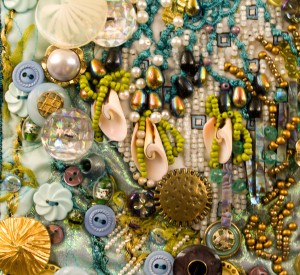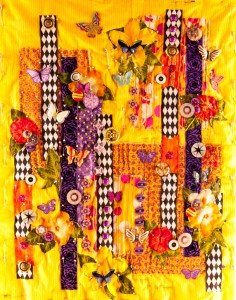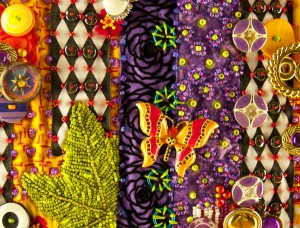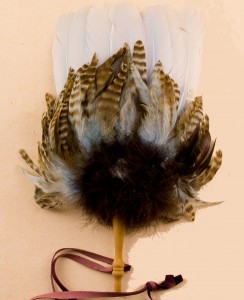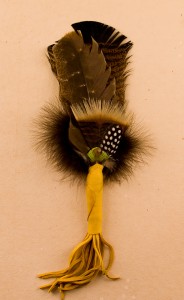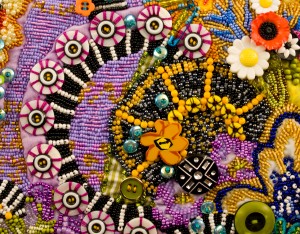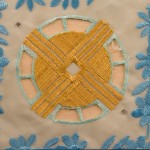 While I often bemoan when I feel the futility of when I’m “going around in circles” in my life, sometimes I want to do that, or at least include them, in my art work. (Maybe it’s my love of buttons, most of which are round.) The detail shot on the left is a circle that I coveted to have as part of my fabric stash. It’s a golden orb about 3 ” or 7.5cm in diameter, on a field of pale blue organza and embroidered flower motifs that I bought just for the circles. I knew at the time that I would never use the rest of the fabric, it was really expensive, (about $35/yd(m)), but I HAD to have it. You understand, right?
While I often bemoan when I feel the futility of when I’m “going around in circles” in my life, sometimes I want to do that, or at least include them, in my art work. (Maybe it’s my love of buttons, most of which are round.) The detail shot on the left is a circle that I coveted to have as part of my fabric stash. It’s a golden orb about 3 ” or 7.5cm in diameter, on a field of pale blue organza and embroidered flower motifs that I bought just for the circles. I knew at the time that I would never use the rest of the fabric, it was really expensive, (about $35/yd(m)), but I HAD to have it. You understand, right?
 In the center and to the upper right of this detail shot is how I used those orb motifs in the art quilt “Butterflies and Beachballs“. The wedges of the circles, I filled in with gold beads, but left the arms of the orbs uncovered. Despite the opinion of many, I do not cover every square inch of the surface area of my art quilts. I do like to leave some of the original fabric to show through so people can get a sense of what the material looked like before my beading instincts took over.
In the center and to the upper right of this detail shot is how I used those orb motifs in the art quilt “Butterflies and Beachballs“. The wedges of the circles, I filled in with gold beads, but left the arms of the orbs uncovered. Despite the opinion of many, I do not cover every square inch of the surface area of my art quilts. I do like to leave some of the original fabric to show through so people can get a sense of what the material looked like before my beading instincts took over.
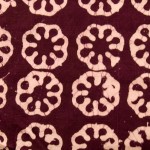 These batik fabric circles were used a lot in my early quilts. I used them so much, that a friend finally wailed,”Nance, quit using those batik circles!”. I like motifs that have distinct delineation between themselves and the background color and clean divisions in the parts of the interior of the designs. Fortunately, I still have a lot of this fabric left, as it was purchased back when I bought 3 yards of any fabric I thought I’d like. My budget often puts on some constraints. However, an even bigger consideration is the bend in the shelves on which the fabric is stored. Who knew that a “few” lengths of dress-weight material could create such a weight load.
These batik fabric circles were used a lot in my early quilts. I used them so much, that a friend finally wailed,”Nance, quit using those batik circles!”. I like motifs that have distinct delineation between themselves and the background color and clean divisions in the parts of the interior of the designs. Fortunately, I still have a lot of this fabric left, as it was purchased back when I bought 3 yards of any fabric I thought I’d like. My budget often puts on some constraints. However, an even bigger consideration is the bend in the shelves on which the fabric is stored. Who knew that a “few” lengths of dress-weight material could create such a weight load.
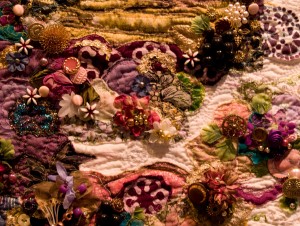 The batik circles worked well, I feel, in this detail shot of “Dinner for Three on the Banks of the Cabernet” -1993. It’s from my “Wines of the World” series, which I’ve yet to write about. The inspiration for the piece was a lagoon that I saw in the savannas of Venezuela which was purple/red (like a Cabernet) from the tannin in the local vegetation. The batik circles here played off the rubber/plastic grape clusters that were sewn to the surface of the quilt. In the upper right is an example of one of my early attempts to stencil on to fabrics. I quickly gave that up, because at the time, there were no textile paints intense enough to give me the color saturation that I wanted.
The batik circles worked well, I feel, in this detail shot of “Dinner for Three on the Banks of the Cabernet” -1993. It’s from my “Wines of the World” series, which I’ve yet to write about. The inspiration for the piece was a lagoon that I saw in the savannas of Venezuela which was purple/red (like a Cabernet) from the tannin in the local vegetation. The batik circles here played off the rubber/plastic grape clusters that were sewn to the surface of the quilt. In the upper right is an example of one of my early attempts to stencil on to fabrics. I quickly gave that up, because at the time, there were no textile paints intense enough to give me the color saturation that I wanted.
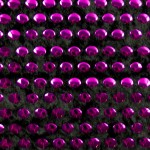 Sometimes I cut my own circles if the size is not what I wanted. These metallic circles (about 1/2″ or 1.3 cm) are bonded onto a short pile, black velour. This is one fabric that I wish I had bought more of as I found out the hard way that the metallic foil, while thicker than sequin material, melts when you try to iron it. Sigh… I found a good brand of iron cleaner in the local fabric store in the notions section that got the sticky mess off the sole plate of my very expensive iron. It lived to iron another day. When I was little, I hated to iron my father’s shirts, and tablecloths. Who knew that I would pick a profession that often requires a lot of ironing, Of course, I don’t iron my own clothes!
Sometimes I cut my own circles if the size is not what I wanted. These metallic circles (about 1/2″ or 1.3 cm) are bonded onto a short pile, black velour. This is one fabric that I wish I had bought more of as I found out the hard way that the metallic foil, while thicker than sequin material, melts when you try to iron it. Sigh… I found a good brand of iron cleaner in the local fabric store in the notions section that got the sticky mess off the sole plate of my very expensive iron. It lived to iron another day. When I was little, I hated to iron my father’s shirts, and tablecloths. Who knew that I would pick a profession that often requires a lot of ironing, Of course, I don’t iron my own clothes!
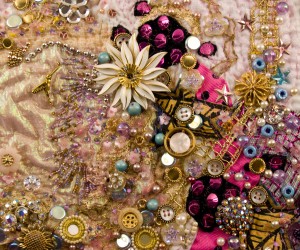 This is a detail of the art quilt, “Laughter“.Showing in the top middle and bottom right of the photo is where I made circles out of circles from the shiny fabric shown above. It was a little hard to cut between the velour to make the circle because of the alignment of the foil circles. Even harder was to cut out individual circles and attach them, as there was so little fabric around each circle to sew into. That experiment with the individual circles was quickly abandoned. There are also some of my favorite embellishment materials, shi-sha mirrors from India, here shown in the bottom of the photo, banded in gold and edged with tiny pearls.
This is a detail of the art quilt, “Laughter“.Showing in the top middle and bottom right of the photo is where I made circles out of circles from the shiny fabric shown above. It was a little hard to cut between the velour to make the circle because of the alignment of the foil circles. Even harder was to cut out individual circles and attach them, as there was so little fabric around each circle to sew into. That experiment with the individual circles was quickly abandoned. There are also some of my favorite embellishment materials, shi-sha mirrors from India, here shown in the bottom of the photo, banded in gold and edged with tiny pearls.
Going around in circles, or at least using them as design elements in my art work, is not such a bad idea. There are lots of round materials from which to choose, as the shape tends not to catch on things when used on clothes and slips easily through buttonholes. Besides, it’s a great conversation starter when asked what do I do for a living. I can blthely say, “I go around in circles. However, only the very best ones!”
What are some of your favorite shapes to utilize in your art work? Why do you think that you’re drawn to them?
Why not leave a comment as to your thoughts on this posting. Please take a minute, fill out the form by clicking on the “comments/no comments link” at the top of the posting, and then share your ideas with the rest of us. We all grow when we share our thoughts and impressions, so why not join our growing community of those who appreciate art quilts and textile arts. We’d love to hear from you!
You can see more of my art work on my web site at www.fiberfantasies.com

